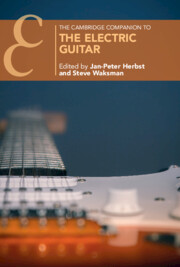Book contents
- The Cambridge Companion to the Electric Guitar
- Cambridge Companions to Music
- The Cambridge Companion to the Electric Guitar
- Copyright page
- Contents
- Figures
- Tables
- Contributors
- 1 Introduction
- Part I History
- Part II Technology and Timbre
- Part III Musical Style and Technique
- Part IV The Electric Guitar in Society
- Part V The Global Instrument
- Personal Take V: Azmyl Yunor
- 16 African Electrical Networks
- 17 Rhythm, Rasta, Rock, and “Electric Avenue”: The Electric Guitar in Anglo-Caribbean Popular Music
- 18 The Electric Guitar in Southeast Asia: A Serpentine Path
- Index
- References
18 - The Electric Guitar in Southeast Asia: A Serpentine Path
from Part V - The Global Instrument
Published online by Cambridge University Press: 08 November 2024
- The Cambridge Companion to the Electric Guitar
- Cambridge Companions to Music
- The Cambridge Companion to the Electric Guitar
- Copyright page
- Contents
- Figures
- Tables
- Contributors
- 1 Introduction
- Part I History
- Part II Technology and Timbre
- Part III Musical Style and Technique
- Part IV The Electric Guitar in Society
- Part V The Global Instrument
- Personal Take V: Azmyl Yunor
- 16 African Electrical Networks
- 17 Rhythm, Rasta, Rock, and “Electric Avenue”: The Electric Guitar in Anglo-Caribbean Popular Music
- 18 The Electric Guitar in Southeast Asia: A Serpentine Path
- Index
- References
Summary
This chapter introduces the electric guitar in Southeast Asia through its history, cultural and political significance, and signature within locally popular genres of music. For more than seventy years, the electric guitar has been a technology for aesthetic innovation and cultural exchange, inspiring new genres and intraregional scenes, and new playing techniques, instrumentation, and instrument manufacturing and trade. It has also been an agent of transformation for musicians, audiences, and even nations, attending to colliding epochs of decolonization, nation-building, authoritarianism, and neoliberalism. It has inspired youth reverie and dissent, and censorship and oppression—a maligned symbol of Western imperialism and an essential tool of expressive freedom. The electric guitar has much to tell us about what Waksman calls “a deeper shift in the cultural disposition toward sound” and noise, as Southeast Asian guitarists have broadened their tonal and timbral palettes with new possibilities in electronic signaling, amplification, and distortion. But it has an equally important role in helping us understand the residual impacts of colonization, the rise of nations and youth cultures, and Southeast Asia’s past, present, and future.
- Type
- Chapter
- Information
- The Cambridge Companion to the Electric Guitar , pp. 325 - 344Publisher: Cambridge University PressPrint publication year: 2024

